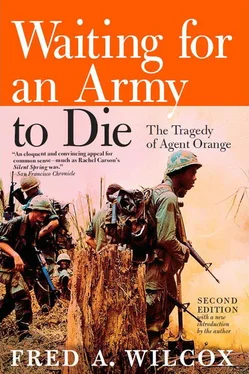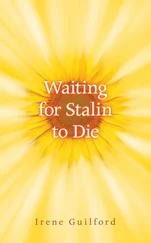Christopher H. Johnson is a Vietnam veteran, but his testimony could be that of any American parent or victim of toxic poisoning. Although the Vietnam War has ended, the Vietnamization of America continues unabated. Vietnam veterans are our future, and however painful that may be for us to admit, our future is now.
The History of 2,4,5-T [27] From Northwest Coalition for Alternatives to Pesticides.
1941–1946:Tests and development as a chemical and biological warfare agent.
1946:Commercial use on weeds and brush.
Late 1961:Introduced in Vietnam as part of US chemical warfare.
June/July 1969:Reports of frequent birth defects in defoliated areas of Vietnam.
April 1970:Pentagon stops using Agent Orange due to worldwide pressure and significant scientific evidence.
April 1970:Surgeon General reports to Hart committee on restrictions of 2,4,5-T: suspension of liquid formulation for home use; suspension of all aquatic uses; intent to cancel registration of nonliquid formulations for use around homes and on all food crops.
May 1970:Dow et al. appeals decision to cancel use on food crops.
Late 1970:Lawsuit by Consumers Union to force Department of Agriculture to suspend rather than cancel use.
1970:Environmental Protection Agency takes over regulation of pesticides.
January 1971:Appeals court orders EPA to reconsider Department of Agriculture refusal to put firmer restrictions on 2,4,5-T.
May 1971:Science advisory panel set up by EPA recommends that ban on use around homes be lifted and other restrictions set aside. Many scientists severely criticize advisory panel.
August 1971:EPA administrator William Ruckelshaus announces EPA would continue to press for cancellation of 2,4,5-T on food crops and orders hearing on uses causing greatest human exposure.
September 1971:Dow asks and gets an injunction from district court in Arkansas stopping EPA from cancellation hearings.
April 1973:Appeals court reverses district court decision and upholds EPA order for cancellation.
July 1973:EPA plans go-ahead for cancellation hearings, begins pre-hearing conferences with Dow, Department of Agriculture, Consumers Union and Environmental Defense Fund.
May 1974:Dow and Department of Agriculture hold conference on 2,4,5-T.
June 1974:EPA withdraws order of intent to hold hearings scheduled to begin the following month. Also withdraws cancellation order on rice crop use.
1975:President Gerald Ford announces that the United States would make no first use of military herbicides in offensive operations.
1975:US Forest Service prohibited from using 2,4,5-T in Arkansas because of NEPA violations.
1976:US Forest Service in Region 6 voluntarily suspends use of 2,4,5-T while court case against Siuslaw National Forest is in process.
1977:US Forest Service found to violate NEPA process regarding Environmental Impact Statement in uses of 2,4,5-T.
April 1978:EPA issues notice of Rebuttal Presumption Against Registration (RPAR) for 2,4,5-T.
February 1979:EPA issues order of emergency suspension for 2,4,5-T and 2,4,5-TP (Silvex). First emergency suspension.
Suspend products registered for forestry, right-of-way, pasture, home, aquatic, and recreational area uses of 2,4,5-TP.
EPA initiates cancellation proceedings for 2,4,5-T and 2,4,5-TP suspended uses.
April 1979:Dow fails to win appeal of emergency suspension.
February 1980:EPA cancellation hearings begin. Dow Chemical Corporation and 54 intervenors on their behalf/EPA and 2 intervenors on their behalf.
March 1981:EPA agrees with Dow-initiated motion for suspending cancellation hearings, and begins closed-door meetings to pursue out-of-hearing settlement.
Employment of Riot Control Agents, Flame, Smoke , Antiplant Agents, and Personnel Detectors in Counterguerilla Operations
Department of the Army Training Circular
TC 3-16 April 1969
ANTIPLANT AGENT OPERATIONS
Section 1
Technical Aspects
51. General. Antiplant agents are chemical agents which possess a high offensive potential for destroying or seriously limiting the production of food and defoliating vegetation. These compounds include herbicides that kill or inhibit the growth of plants; plant growth regulators that either regulate or inhibit plant growth, sometimes causing plant death; desiccants that dry up plant foliage; and soil sterilants that prevent or inhibit the growth of vegetation by action with the soil. Military applications for antiplant agents are based on denying the enemy food and concealment.
52. Antiplant Agents in Use.
a. ORANGE .
(1) Description . Agent ORANGE is the Standard A agent. It is composed of a 50:50 mixture of the n-butyl esters of 2,4-D and 2,4,5-T (app D and C1, TM 3-215). ORANGE appears as a dark-brown oily liquid which is insoluble in water but miscible in oils such as diesel fuel. It weighs about 10.75 pounds per gallon and becomes quite viscous as the temperature drops, solidifying at 45°F. It is noncorrosive, of low volatility, and nonexplosive, but deteriorates rubber.
(2) Rate of application . The recommended rate of application of ORANGE is 3 gallons per acre. This may vary depending on the type of vegetation (app C). In some situations better coverage may be obtained by diluting ORANGE with diesel fuel oil, which results in a less viscous solution that is dispersed in smaller droplets. Dilution may also be required when using dispersion equipment which does not permit the flow rate to be conveniently adjusted to 3 gallons per acre. See discussion of application methods in paragraphs 57 and 58.
(3) Effect on foliage . ORGANGE penetrates the waxy covering of leaves and is absorbed into the plant system. It affects the growing points on the plant, resulting in its death. Rains occurring within the first hours after spraying will not reduce the effectiveness of ORANGE to the extent that they reduce the effectiveness of aqueous solutions. Broadleaf plants are highly susceptible to ORANGE. Some grasses can be controlled but require a much higher dose rate than broadleaf plants. Susceptible plants exhibit varying degrees of susceptibility to ORANGE. Death of a given plant may occur within a week or less, or may require up to several months depending on the plant’s age, stage of growth, susceptibility, and the dose rate. See employment considerations in paragraphs 53 through 55.
(4) Safety precautions and decontamination . ORANGE is relatively nontoxic to men or animals. No injuries have been reported to personnel exposed to aircraft spray. Personnel subject to splashes from handling the agent need not be alarmed, but should shower and change clothes at a convenient opportunity. ORANGE is noncorrosive to metals but will remove aircraft paint and walkway coatings. Contaminated aircraft should be washed with soapy water to remove the agent. Rubber hoses and other rubber parts of transfer and dissemination equipment will deteriorate and require replacement, since ORANGE softens rubber.
b. BLUE (Phytar 560G) .
(1) Description . Agent BLUE is an aqueous solution containing about 3 pounds per gallon of the sodium salt of cacodylic acid, the proper amount of surfactant (a substance which increases the effectiveness of the solution), and a neutralizer to prevent corrosion of metal spray apparatus. BLUE is the agent normally used for crop destruction.
Читать дальше











